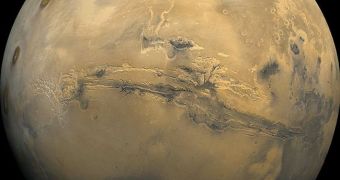Years ago, when the Space Age was in its earliest days, rigorous rules forced space-faring nations to sterilize their spacecraft before sending them to another celestial body. At this point, it's estimated that more than 1 trillion bacterial and microbial spores have made their way to these bodies.
A paper published some time ago in the journal Advances in Space Research shows that, for the past 40 years, missions to Mars, Jupiter, Saturn's moons, comets and asteroids have been improperly sterilized.
There are countless species of microorganisms that have been proven capable to withstand the harsh conditions of outer space, in experiments carried to orbit by the space shuttles, or conducted aboard the International Space Station (ISS).
According to the United Nations Outer Space Treaty of 1967, which is signed by all nations with space ambitions, agencies and government interested in exploring the solar system need to ensure that they avoid contaminating their targets, and also that they do not bring foreign contaminants back.
“Parties to the Treaty shall pursue studies of outer space, including the Moon and other celestial bodies, and conduct exploration of them so as to avoid their harmful contamination and also adverse changes in the environment of the Earth resulting from the introduction of extraterrestrial matter,” it says.
But we have already placed several rovers and lander on Mars, including Spirit, Opportunity and Phoenix, and at least three mission crashed on the surface of the Red Planet.
Given that we are just beginning our quest to find life outside the boundaries of our planet, into the solar system and beyond, we simply cannot afford to have planets contaminated with life that originated here before we have a chance to send over capable probes to detect native life.
When all is said and done, the fact remains that we still don't know if bacteria and microbes can survive on Mars. Given their potential to adapt – demonstrated countless times on Earth – it's not far-fetched to say that they may indeed endure.
If so, experts ask, why should we risk contaminating the most Earth-like planet around? Plans are already underway to breach the UN agreement, and they are set in motion by the Russian Federation.
In 2001, RosCosmos will launch the Phobos Sample Return Mission, which is headed for the Martian moon Phobos. In addition to harvesting samples from its surface, the spacecraft will also be carrying into space the first live bacteria – and it will do so on purpose.
The Russian estimate that the mission – which will carry live bacteria in sealed capsules – will last for about three years. Experts want to learn whether micro-organisms can withstand the harsh conditions such a travel implies.
If so, then the theory of transpermia – holding that life may be exchanged between planets and moons – could finally be proven true, But the risks of the Russian mission are too great to ignore. Past attempts to launch on Phobos have failed, twice.
The mission profile the spacecraft has is among the most complex in the history of space exploration, including many dangerous maneuvers. As such, the potential for failure, and therefore contamination, is very great, New Scientist reports.

 14 DAY TRIAL //
14 DAY TRIAL //